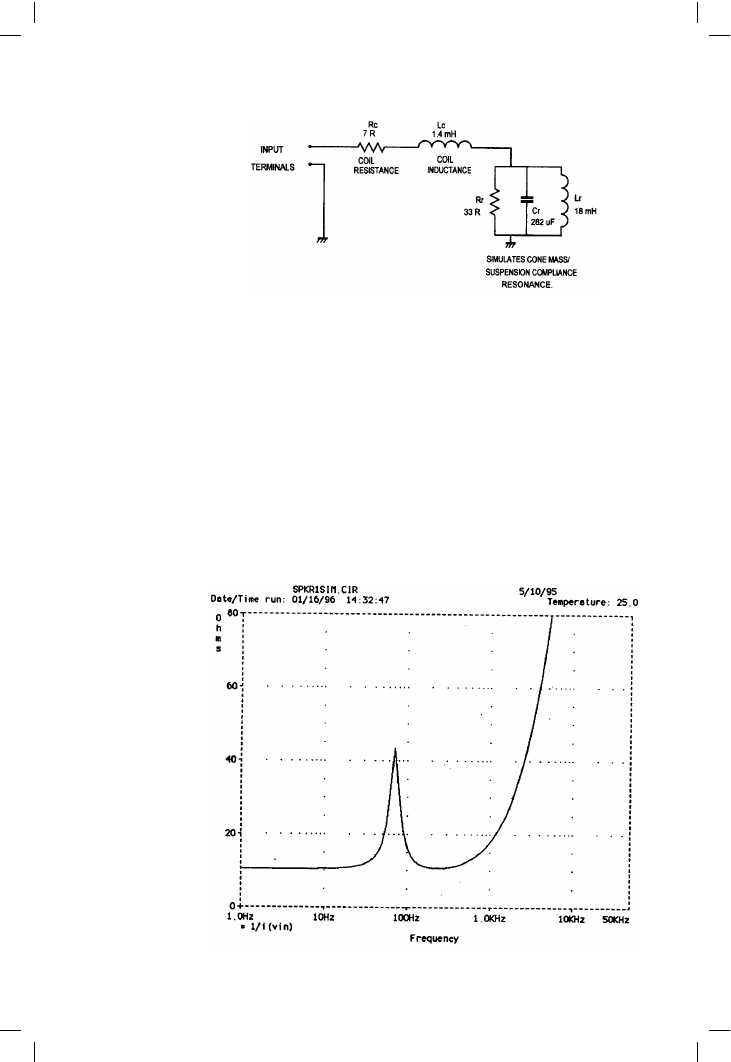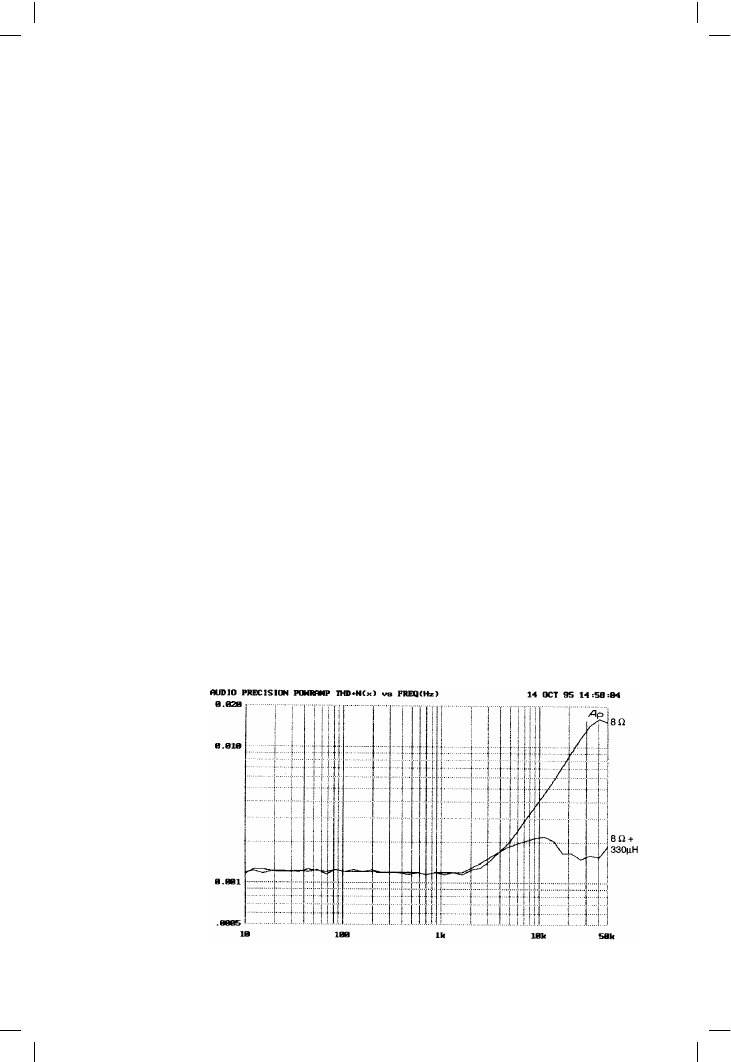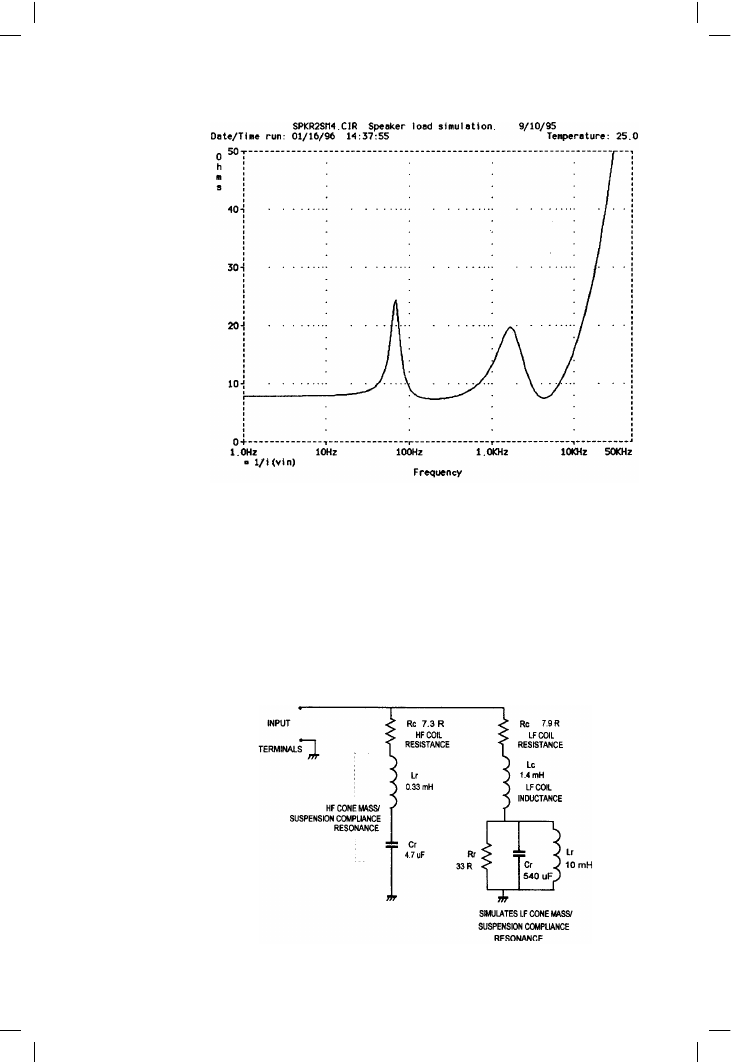ВУЗ: Казахская Национальная Академия Искусств им. Т. Жургенова
Категория: Учебное пособие
Дисциплина: Не указана
Добавлен: 03.02.2019
Просмотров: 17429
Скачиваний: 18

Audio Power Amplifier Design Handbook
Modelling real loudspeaker loading
The impedance curve of a real loudspeaker may be complex, with multiple
humps and dips representing various features of the speaker. The resonance
in the bass driver unit will give a significant hump in LF impedance, with
associated phase changes. Reflex (ported enclosure) designs have a
characteristic double-hump in the LF, with the middle dip corresponding to
the port tuning. The HF region is highly variable, and depends in a
complicated fashion on the number of drive units, and their interactions
with the crossover components.
Connection of an amplifier to a typical speaker impedance rather than a
resistance has several consequences:
!
The frequency response, measured in terms of the voltage across the
loudspeaker terminals, shows small humps and bumps due to the
uneven impedance loading the series combination of amplifier output
impedance and connecting cable resistance.
!
Severe dips in impedance may activate the overload protection circuitry
prematurely. This has to be looked at in terms of probability, because a
high amplitude in a narrow frequency band may not occur very often,
and if it does it may be so brief that the distortion generated is not
perceptible. Amplitudes are higher at LF and so impedance dips here are
potentially more serious.
!
The variable loading affects the distortion performance.
Figure 7.25 shows how the HF crossover distortion varies with load
resistance for loads lighter than those usually considered. Even 68 !
loading increases HF distortion.
210
Figure 7.25
The reduction of HF
THD as resistive
amplifier loading is
made lighter than 8 !

Compensation, slew-rate, and stability
Figure 7.26 shows an electrical model of a single full-range loudspeaker
unit. While a single-driver design is unlikely to be encountered in hi-fi
applications, many PA, disco and sound reinforcement applications use
full-range drive units, for which this is a good model. Rc and Lc represent
the resistance and inductance of the voicecoil. Lr and Cr model the
electromechanical resonance of the cone mass with the suspension
compliance and air-spring of the enclosure, with Rr setting the damping;
these last three components have no physical existence, but give the same
impedance characteristics as the real resonance.
The input impedance magnitude this network presents to an amplifier is
shown in Figure 7.27. The peak at 70 Hz is due to the cone resonance;
without the sealed enclosure, the restoring force on the cone would be less
211
Figure 7.26
Electrical model of a
single speaker unit in a
sealed enclosure
Figure 7.27
Input impedance of
single speaker unit

Audio Power Amplifier Design Handbook
and the free-air resonance would be at a lower frequency. The rising
impedance above 1 kHz is due to the voicecoil inductance Lc.
When the electrical model of a single-unit load replaces the standard 8 !
resistive load, something remarkable happens; HF distortion virtually
disappears, as shown in Figure 7.28. This is because a Blameless amplifier
driving 8 ! only exhibits crossover distortion, increasing with frequency as
the NFB factor falls, and the magnitude of this depends on the current
drawn from the output stage; with an inductive load this current falls at high
frequencies.
Most hi-fi amplifiers will be driving two-way or three-way loudspeaker
systems, and four-way designs are not unknown. This complicates the
impedance characteristic, which in a typical two-way speaker looks
something like Figure 7.29, though the rise above 10 kHz is often absent.
The bass resonance remains at 70 Hz as before, but there are two drive
units, and hence two resonances. There is also the considerable complica-
tion of a crossover network to direct the HF to the tweeter and the LF to the
low-frequency unit, and this adds several extra variables to the situation. In
a bass reflex design the bass resonance hump may be supplemented by
another LF resonant peak due to the port tuning. An attempt at a
representative load simulator for a two-way infinite-baffle loudspeaker
system is shown in Figure 7.30. This assumes a simple crossover network
without compensation for rising tweeter coil impedance, and is partially
based on a network proposed by Ken Kantnor in Atkinson
[11]
.
Some loudspeaker crossover designs include their own Zobel networks,
typically placed across the tweeter unit, to compensate for the HF rise in
impedance due to the voicecoil inductance. If these Zobels are placed
there to terminate the crossover circuitry in a roughly resistive load, then
the loudspeaker designer has every right to do it; electroacoustic design is
212
Figure 7.28
The reduction of HF
THD with an inductive
load; adding 330 µH
in series with the 8 !
reduces the 20 kHz
THD by more than four
times

Compensation, slew-rate, and stability
quite difficult enough without adding extra restrictions. However, if they
are incorporated simply to make the impedance curve look tidier, and
allow a claim that the load has been made easier for the amplifier to drive,
then this seems misguided. The actual effect is the opposite; a typical
amplifier has no difficulty driving an inductive reactance, and the HF
crossover distortion can be greatly reduced when driving a load with an
impedance that rises above the nominal value at HF.
This is only an introduction to the huge subject of real amplifier loads.
More detailed information is given in Benjamin
[12]
.
213
Figure 7.29
The circuit of the 2-way
speaker model
Figure 7.30
The circuit of the 2-way
speaker model

Audio Power Amplifier Design Handbook
Loudspeaker loads and output stages
There is a common assumption that any reactive load is more difficult for
an amplifier to drive than a purely resistive one; however, it is devoutly to
be wished that people would say what they mean by ‘difficult’. It could
mean that stability margins are reduced, or that the stresses on the output
devices are increased. Both problems can exist, but I suspect that this belief
is rooted in anthropomorphic thinking. It is easy to assume that if a signal
is more complex to contemplate, it is harder for an amplifier to handle. This
is not, however, true; it is not necessary to understand the laws of physics
to obey them. Everything does anyway.
When solid-state amplifiers show instability it is always at ultrasonic
frequencies, assuming we are not grappling with some historical curiosity
that has AC coupling in the forward signal path. It never occurs in the
middle of the audio band although many loudspeakers have major
convulsions in their impedance curves in this region. Reactive loading can
and does imperil stability at high frequencies unless precautions are taken,
usually in the form of an output inductor. It does not cause oscillation or
ringing mid-band.
Reactive loads do increase output device stresses. In particular peak power
dissipation is increased by the altered voltage/current phase relationships in
a reactive load.
214
Single-speaker load
Considering a single speaker unit with the equivalent circuit of Figure 7.26,
the impedance magnitude never falls below the 8 ! nominal value, and is
much greater in some regions; this suggests the overall amplifier power
dissipation would be less than for an 8 ! resistive load.
Unfortunately this is not so; the voltage/current phase relationship brought
about by the reactive load is a critical factor. When a pure resistance is
driven, the voltage across the output device falls as the current through it
rises, and they never reach a maximum at the same time. See Figure 7.31,
for Class-B with an 8 ! resistive load. The instantaneous power is the
product of instantaneous current and voltage drop, and in Class-B has a
characteristic two-horned shape, peaking twice at 77 W during its
conducting half-cycle.
When the single-speaker load is driven at 50 Hz, the impedance is a mix of
resistive and inductive, at 8.12 + 3.9 j!. Therefore the current phase-lags
the voltage, altering the instantaneous product of voltage and power to that
shown in Figure 7.32. The average dissipation over the Class-B half-cycle
is slightly reduced, but the peak instantaneous power increases by 30% due
to the voltage/current phase shift. This could have serious results on
amplifier reliability if not considered at the design stage. Note that this